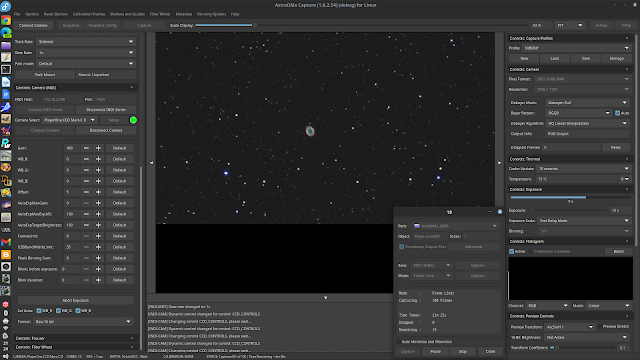Using a Player One Mars-C II USB3.0 OSC camera as an INDI camera for uncooled deep sky imaging.
The Mars-C II camera uses a Sony IMX662 CMOS sensor which has no amp glow. Dark-frames are advisable because the camera does have a few coloured hot pixels, but very few. The equipment used was an F=440mm, 80mm ED refractor, mounted on a Celestron AVX GOTO mount. A Raspberry Pi 4B and Goodmans 5v power supply were mounted dorsally on the scope and a Pegasus Focus Cube Version 2 was attached to the focuser, powered by a 12 power pack and controlled by the Raspberry Pi INDI server. The Guide-scope was an SVBONY SV165 fitted with a QHY-5II-M camera.
The setup was controlled by a Fedora Linux laptop indoors (but it could just as easily have been a macOS or Windows machine). Wifi was used in this case, but hard wired ethernet control could have been used.
Click on any image to get a closer view
The control computer imaging the Crescent nebula
The equipment used
The mount/scope was given a 3 star alignment and a Bahtinov mask was used to facilitate focusing and the scope was focused on the last alignment star. Here the star is almost perfectly focused.
Imaging the Crescent nebula. (An LeNhance narrowband filter was used.)
AstroDMx Capture was used to control the INDI server, to locate, plate-solve and centre the object in the field of view.
The Player One Mars-C II camera was used as an INDI camera. It was noticed that the driver defaults to 8 bits, so it is necessary to change this to 16 bits for Deep Sky imaging.
It should be noted that INDI cameras would never be used for solar system imaging, as they are very slow compared with the same cameras directly implemented.
Auto-guiding was by PHD2 running on a server on a separate Linux computer. This is our usual configuration for sharing the processes during imaging. There are those who prefer to start everything off and just leave the equipment to capture the images. However, we find it preferable to monitor the auto-guiding. As time passes and the balance changes imperceptibly, or sky conditions change, or when one is imaging in a particular part of the sky, it is sometimes necessary to intervene and make small changes to aggressiveness, for example, in order to optimise the guiding as much as possible.
AstroDMx Capture was used to capture an hour’s worth of 1 minute FITS exposures of the Crescent nebula along with 20 matching dark frames.
The data were calibrated, registered and stacked in Siril and post processed in the Gimp.
The Crescent Nebula
Imaging the Ring nebula. (An IR/UV cut filter was used.)
AstroDMx Capture was used to acquire, centre the object and then capture 30 minutes worth of 15s exposures of M57 along with matching dark frames.
The data were calibrated, registered and stacked in Siril and post processed in the Gimp.
M57, the Ring nebula
Imaging M27, the Dumbbell nebula. (An LeNhance narrowband filter was used.)
This time the INDI server running on the Raspberry Pi was also used by PHD2 for auto-guiding as well as controlling the mount and the Pegasus Focus Cube Version 2 motor focuser and controlling the Player One Mars-C II camera as an INDI camera.
AstroDMx Capture was used to acquire, centre M27 and capture on hour’s worth of 90s FITS exposures plus 10 matching dark frames.
The data were calibrated, registered and stacked in Siril and post processed in the Gimp.
M27, the Dumbbell nebula
These tests performed over two nights without any problems. AstroDMx Capture did it’s job perfectly and the Player One Mars-C II camera was a good match for the telescope, giving a good image scale for the objects imaged and proving to be a very capable uncooled deep sky camera, performing well as an INDI camera.
More field tests have to be performed and some changes to the code will be required before a new release of AstroDMx Capture will be made implementing some advanced features.








